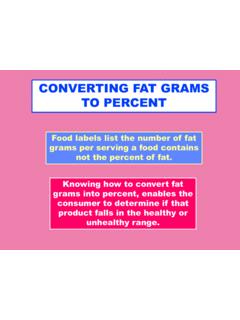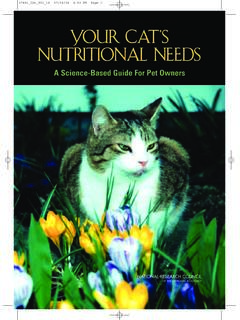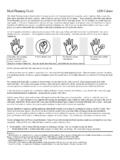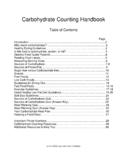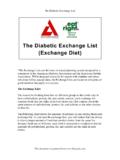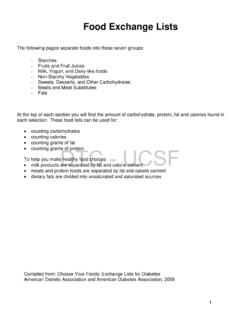Transcription of Session 2: Be a Fat and Calorie Detective
1 DPP-Group Lifestyle Balance - Session 2 Copyright 2017 University of Pittsburgh Page 1 Session 2: Be a Calorie Detective To help you lose weight, we ll help you build healthy eating habits. Healthy eating involves eating fewer calories , less fat, and less unhealthy fat. Eating fewer calories . Eating or drinking too many calories from any type of food or drink can cause weight gain. Being overweight or obese increases your risk of heart attack, stroke, and diabetes. Eating less fat. Fat has more than twice the calories as the same amount of sugar, starch, or protein.
2 Even small amounts of high-fat foods are high in calories . With lower fat foods, you can eat more and feel fuller on fewer calories . Note: Low-fat or fat-free foods still contain calories . Read the label. Compare calories * Fat Grams* 2 cups of cheese curls (2 -ounce bag) 370 24 5 cups of 94% fat-free microwave popcorn 110 2 * These values are averages. Always check labels. Eating less unhealthy fat. Too much unhealthy fat can raise your level of bad cholesterol. It may also increase your chances of having a heart attack or stroke or getting diabetes.
3 DPP-Group Lifestyle Balance - Session 2 Copyright 2017 University of Pittsburgh Page 2 Group Lifestyle Balance Calorie and fat gram Goals To get started losing weight, stay as close as you can to your Calorie and fat gram goals. They are shown in the chart below. Find your starting weight. Your Calorie and fat gram goals are in the same row. Circle them. Write them on your Weekly Record. Starting Weight (pounds) Daily Calorie Goal Daily fat gram Goal 120-174 1,200 33 175-219 1,500 42 220-249 1,800 50 250 or more 2,000 55 A gram is the way fat in food is measured.
4 It is a unit of weight. A paper clip weighs about 1 gram . About your Calorie and fat gram goals: It may be hard to reach your goals at first. Just try to get as close to them as you can. Everyone is different. Research has shown that these goals are a good starting point. They are designed to help you lose about 1-2 pounds per week. Aiming for a goal of about 25% (one-quarter) of calories from fat means this is a moderate fat, not a low-fat eating plan. It s important not to go too low. Do NOT try to see how few calories and fat grams you can eat.
5 You need to get enough food for health and good nutrition. DPP-Group Lifestyle Balance - Session 2 Copyright 2017 University of Pittsburgh Page 3 How and Why to Measure Foods If you measure food at home, you will: Know the calories that you eat and drink. See what a moderate portion looks like. Be better at guessing amounts when eating away from home. Most people are surprised when they measure foods. Let s look at some examples: Write down the name of the food . Guess the amount.
6 Write down the actual amount. Figure the Calorie and fat grams for the actual amount. food Guessed Amount Actual Amount calories Fat Grams Measuring foods will help you help you stay within your Calorie and fat gram goals. Measuring cups For solid foods: Fill and level off. For liquids: Fill. Read the line at eye level. Measuring spoons Fill and level off. Measuring/Estimating Meat and Cheese Estimate the portion size. o 4 ounce raw = 3 ounce cooked (about the size of a deck of cards or the palm of your hand).
7 Some people find it helpful to use a food scale. o Weigh meats after they are cooked with the fat and bone removed. DPP-Group Lifestyle Balance - Session 2 Copyright 2017 University of Pittsburgh Page 4 Keep Track of the calories and Fat You Eat Every Day 1. Record everything you eat and drink. It's the most important part of changing your behavior. Spelling is NOT important. What IS important is to: Be honest. (Record down what you really eat.) Be accurate. (Measure portions, find Calorie and fat information.)
8 Be complete. (Include everything.) 2. Figure out how many Calorie and fat grams are in everything you eat and drink. Record it. Find the serving size, Calorie , and fat gram information by using: o food labels. Always use label values if you can. They are the most up-to-date and exact. o Calorie and fat counter. Use a book or digital option. o Menus, menu boards, or displays at some restaurants, bakeries, and coffee shops. Compare the amount YOU ate or drank with the amount listed on the label, Calorie and Fat Counter, or menu.
9 Figure out how many Calorie and fat grams are in the amount you ate or drank. 3. Add up the Calorie and fat grams you eat and drink during the day. Subtotal the Calorie and fat grams in each meal and snack. Doing so will help you stay on track with your goals. Transfer the daily totals of calories and fat grams to the back cover of your Keeping Track book. DPP-Group Lifestyle Balance - Session 2 Copyright 2017 University of Pittsburgh Page 5 Eat a Packaged food ? Read the Nutrition Facts Label Look at the Serving size.
10 Look at the calories per serving. Look at the Total Fat Grams per serving. Question: What if you eat a larger serving than is listed on the label? Answer: You will be eating more calories and fat grams than are listed on the label. DPP-Group Lifestyle Balance - Session 2 Copyright 2017 University of Pittsburgh Page 6 When You Use the Calorie and Fat Counter Can't find a food ? Use the calories and fat grams for a food that s the most like it. For example, use nut bread for zucchini bread.

